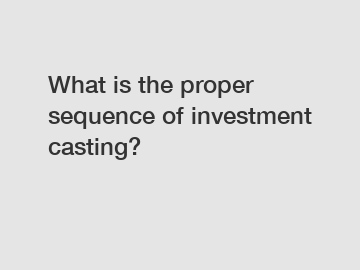What is the proper sequence of investment casting?
Investment casting is a highly specialized manufacturing process that allows for the creation of complex and intricate metal parts with high accuracy. Also known as lost wax casting, this technique has been in use for thousands of years and continues to be a popular choice for various industries, including aerospace, automotive, and jewelry.
Proper sequence of investment casting:
Pattern creation.

The first step in the investment casting process is the creation of a pattern, which is an exact replica of the desired metal part. Patterns can be made from various materials like wax or plastic. It is crucial to ensure that the pattern is flawless and accurately represents the final product.
Pattern assembly.
Once the pattern is created, it is assembled with other patterns into a pattern cluster. The cluster is then attached to a central sprue, which acts as a channel for the molten metal to flow into the mold. The sprue also helps provide a vent for the air and gases to escape during the casting process.
Investment mold creation.
The pattern cluster is then coated with a ceramic shell in a series of steps. This shell is created by repeatedly dipping the cluster into a slurry made of fine ceramic particles mixed with a binder. After each dip, the pattern cluster is coated with a layer of fine sand to enhance the strength of the mold. This process is repeated until the desired thickness of the shell is achieved.
Dewaxing.
Once the ceramic shell is fully dried and hardened, it is placed in a high-temperature oven for dewaxing. The heat melts and vaporizes the pattern, leaving behind a cavity in the shell that perfectly matches the shape of the desired metal part. This step is crucial to ensure that no remnants of the pattern are left, which could cause defects in the final cast.
Preheating and pouring.
After dewaxing, the ceramic shell is preheated to remove any remaining moisture and to bring it to the desired temperature. Meanwhile, the metal that will be used for casting is melted in a furnace. Once both the ceramic shell and the metal are at the correct temperature, the molten metal is poured into the shell through the sprue. Gravity helps ensure that the metal fills the mold completely.
Cooling and shell removal.
After pouring, the filled shell is allowed to cool and solidify. The cooling time depends on the size and complexity of the part being cast. Once the metal has solidified, the ceramic shell is carefully broken away, revealing the metal part within. The excess metal from the sprue and other gating system components is removed, and the final cast is obtained.
Finishing.
The final step in the investment casting process is finishing the cast part. It may involve grinding, machining, polishing, or any other necessary processes to achieve the desired dimensional accuracy and surface finish. This step ensures that the cast part meets all the required specifications and is ready to be used or assembled into the final product.
Investment casting offers numerous advantages, such as the ability to create complex shapes, excellent surface finish, and near-net-shape parts. Its proper sequence ensures high-quality castings that meet the specific requirements of each industry.
If you have any further questions about investment casting or would like to explore its applications for your specific needs, please do not hesitate to contact us. Our team of experts is always ready to assist you.
For more information, please visit Precision investment casting for textile machinery parts, Investment casting for scientific instrument components, auto parts casting exporter.


